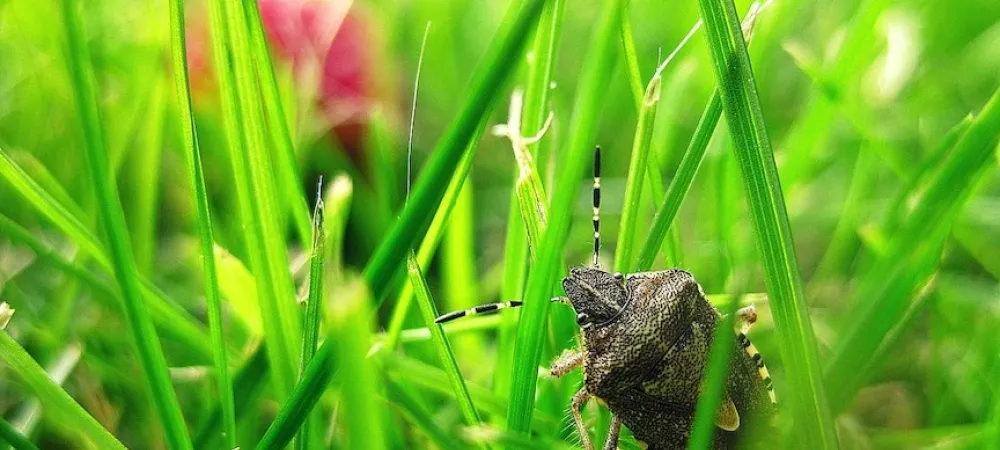The Most Common Fall Pests in North Carolina

As North Carolina transitions into fall, with its picturesque landscapes and crisp air, homeowners are often preoccupied with preparing their homes for the cooler months. However, it's crucial not to overlook a key aspect of fall preparation: pest control. With the change in season, a host of pests are on the move, seeking shelter and food in our homes. Here’s a comprehensive guide to the most common fall pests in North Carolina and how they could become an issue this winter.
Boxelder Bugs
Boxelder bugs are small, roughly 1/2 inch long, and easily identified by their black bodies with striking orange or red markings on their wings and around their edges. They have a distinct, flat, and elongated shape with a noticeable X-pattern on their backs.
Boxelder bugs are often found in clusters and are most active during the warmer days of fall. They are typically seen on the exterior walls of homes, particularly those facing the sun, and can be found congregating in areas around boxelder trees, which are their primary food source.
Winter Concerns
In North Carolina, boxelder bugs seek out the warmth of your home to overwinter. They can become a significant nuisance when they congregate in large numbers inside, particularly around sunny window sills and in corners. Their presence can lead to a messy home with bug remnants and an unpleasant appearance. Additionally, while boxelder bugs do not cause direct harm, their sheer numbers can be unsettling and difficult to manage.
Prevention Tips
- Seal Entry Points: Inspect and seal cracks and gaps around windows, doors, and your home’s foundation using caulk or weatherstripping. Pay special attention to areas where utility lines and pipes enter your home.
- Remove Attractants: Trim or remove boxelder trees and other potential food sources around your home. If you can't remove the trees, keep them well-pruned and away from your home’s exterior.
- Use Insecticides: Apply insecticides or natural repellents around potential entry points, such as door frames and window sills, to deter bugs from entering your home.
- Clean Regularly: Regularly clean areas where boxelder bugs are likely to gather, such as window sills and corners, to remove any existing pests and reduce their appeal.
Stink Bugs
Stink bugs are shield-shaped and typically measure around 1/2 inch to 3/4 inch in length. They come in various colors, including green, brown, and mottled gray. Their most distinctive feature is the triangular-shaped scutellum (the shield-like structure) that covers their back. When disturbed or crushed, stink bugs release a strong, unpleasant odor as a defense mechanism. They are often seen crawling on walls and windows and can occasionally be found inside homes during their search for warmth.
Winter Concerns
Stink bugs seek shelter indoors as temperatures drop, and their presence can be particularly bothersome. When large groups invade, they can be found on walls, windows, and even in attics. Their characteristic odor, which they release when disturbed, can be offensive and difficult to eliminate. Additionally, their large numbers can lead to a significant clean-up job and potential embarrassment if guests are affected.
Prevention Tips
- Seal Gaps and Cracks: Inspect and seal all gaps and cracks around windows, doors, vents, and other entry points. Use high-quality weatherstripping and caulk to close off these areas effectively.
- Maintain Home Seals: Ensure that all window screens are intact and doors close tightly. Replace or repair any damaged screens or door seals.
- Use Insecticides: Consider applying insecticides around entry points and potential breeding grounds to keep stink bugs away.
- Vacuum Regularly: If stink bugs do enter your home, use a vacuum cleaner to remove them rather than crushing them, which can release their unpleasant odor.
Learn more about how to get rid of stink bugs.
Mice and Rats
Mice are small, usually 2.5 to 4 inches long (not including the tail), with slender bodies, large ears, and a pointed snout. Their fur is typically brown or gray. Rats are larger, with bodies ranging from 6 to 10 inches long (not including the tail), and have thicker, more robust bodies, smaller ears, and a blunt snout.
In North Carolina, the most common mice include the house mouse and the field mouse, while common rats include the Norway rat and the roof rat. These rodents are notorious for their gnawing behavior, which they use to enter homes and create nests. Both mice and rats are more active at night and are commonly found near food sources or nesting materials.
Learn more about the most common NC rodents.
Winter Concerns
Mice and rats are more likely to enter homes during the fall and winter in search of warmth and food. They can cause extensive damage by chewing through wires, insulation, and even structural elements of your home. Additionally, their droppings and urine can pose serious health risks, including the spread of diseases such as hantavirus and leptospirosis.
Prevention Tips
- Seal Entry Points: Thoroughly inspect your home for any cracks, holes, or gaps in the foundation, walls, and around pipes. Seal these openings with materials such as steel wool, caulk, or expanding foam.
- Store Food Properly: Keep all food items in airtight containers and regularly clean up crumbs and spills. Avoid leaving pet food out overnight.
- Set Traps: Place traps in areas where you suspect rodent activity, such as under sinks or behind appliances. Consider using both snap traps and live traps.
- Maintain Cleanliness: Regularly clean areas prone to rodent activity, including the kitchen, pantry, and storage areas, to eliminate potential food sources and nesting materials.
Learn more about how to keep rodents away from your NC home.
Termites
Termites are small, pale insects that vary in color from cream to light brown. Worker termites are around 1/8 inch to 1/4 inch long and have soft bodies, while swarmers (winged termites) are about 1/4 inch to 1/2 inch long and have two pairs of wings that are of equal length. Termites are often found in wooden structures and can cause visible damage such as hollowed-out wood.
The most common types of termites in NC are subterranean termites. They are also known to create mud tubes on walls and foundations, which are used to travel between their nests and food sources.
Winter Concerns
While termites are active year-round here in North Carolina, their presence can be more challenging to detect during the winter months. They may cause severe structural damage to your home before signs become visible. Subterranean termites, in particular, are notorious for their silent destruction, which can lead to significant repair costs if not addressed promptly.
Prevention Tips
- Inspect Regularly: Conduct regular inspections of your home’s wooden structures and foundation for signs of termite activity, such as mud tubes, hollowed-out wood, or swarms of winged termites.
- Improve Drainage: Ensure proper drainage around your home’s foundation to prevent moisture buildup, which can attract termites.
- Eliminate Wood-to-Ground Contact: Keep wooden materials, such as firewood and lumber, elevated and away from your home’s foundation.
- Professional Inspection: Schedule annual inspections with a professional pest control service to identify and address any potential termite issues early.
Spiders
Spiders come in a wide range of sizes and colors. The most common types of spider in North Carolina include the common house spider, the wolf spider, and the brown recluse. The brown recluse, while less common, can be dangerous and is identified by its violin-shaped marking. Spiders tend to build webs in undisturbed areas like corners, basements, and attics. They are more noticeable in the fall as they are more active in their search for mates and warmer shelter.
Winter Concerns
As spiders seek shelter indoors, their presence can be alarming, especially if they are venomous species like the brown recluse. Spiders can build webs in hidden areas, leading to unsightly webs and potential bites if disturbed. Their presence can also indicate other pest issues or an unkempt environment.
Prevention Tips
- Eliminate Clutter: Reduce clutter in basements, attics, and storage areas to minimize hiding spots for spiders.
- Seal Entry Points: Ensure that all gaps around windows, doors, and vents are properly sealed. Use silicone caulk to fill in any gaps or cracks.
- Regular Cleaning: Regularly vacuum and dust to remove spider webs and potential egg sacs. Pay special attention to corners and hidden areas.
- Use Spider Repellents: Consider using spider repellents or natural deterrents, such as peppermint oil or vinegar, around entry points and areas where spiders are commonly seen.
Learn more about spider control.
Asian Lady Beetles
Asian lady beetles are often mistaken for the common ladybug but are typically larger, with a more varied color range from orange to red, and can have up to 19 black spots on their wing covers. They have a round, dome-shaped body and can be distinguished by their white "M" shape behind their head. They are particularly attracted to sunny, warm areas and can often be seen on the exterior walls of homes or gathering in large numbers around windows.
Winter Concerns
Asian lady beetles are known for their large numbers and tendency to congregate in homes. While they are not harmful, their sheer presence can be annoying and difficult to manage. They often gather around sunny windows and can create a mess when they die or are crushed.
Prevention Tips
- Seal Entry Points: Seal all gaps around windows, doors, and vents to prevent lady beetles from entering your home. Use weatherstripping and caulk to close off these openings.
- Remove Attractants: Clean and remove any potential food sources or attractants around your home’s exterior. Ensure that your home’s exterior is well-maintained.
- Use Traps: Consider using light traps or pheromone traps designed for lady beetles to reduce their numbers indoors.
- Regular Cleaning: Clean areas where beetles have gathered to remove any remnants and reduce their appeal.
Fall Pest Control
As temperatures drop and leaves fall in North Carolina, it's essential to be proactive about pest control to prevent these common fall pests from becoming a problem this winter. By taking preventive measures and keeping an eye out for early signs of infestation, you can ensure a comfortable and pest-free home throughout the colder months. If you suspect a pest problem or need assistance, don't hesitate to contact our team of local exterminators for professional pest control service here at Triangle Pest Control to keep your home safe and secure year-round.



